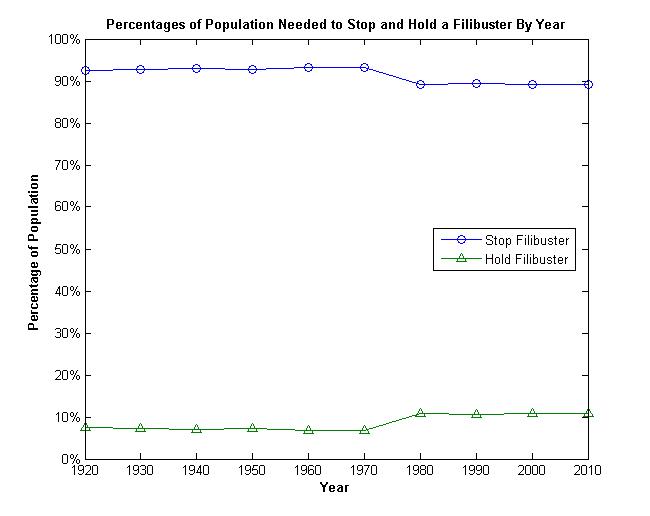“Whereas the Senate in particular has become an obstructive and useless body, a menace to the liberties of the people, and an obstacle to social growth; a body, many of the Members of which are representatives neither of a State nor of its people, but solely of certain predatory combinations, and a body which, by reason of the corruption often attending the election of its Members, has furnished the gravest public scandals in the history of the nation. . . .”
-Victor Berger, from the preamble to the constitutional amendment he introduced in 1911 to abolish the Senate
In last week’s post, I wrote about how the Senate marginalizes minority groups because of the higher proportions of minorities in populous states and white majorities in almost all states. However, the Senate also empowers the minority party in the Senate beyond a reasonable measure. Senate rules dictate that any Senator can speak for an unlimited time about any topic as long as 60 other Senators do not vote to stop the speech. Advocates of the filibuster support the rule to prevent what Alexis de Tocqueville called the “tyranny of the majority.” However, because of skewed representation in the Senate, a group of Senators who represent a small fraction of the country’s population can bring Congress to a standstill and create a “tyranny of the minority” that can stop social progress.
Both the US Senate and House of Representatives originally had a rule called the Previous Question Motion that ended debate with a simple majority. In 1806, the Senate dropped this provision and allowed unlimited debate. The first filibuster began 35 years later in 1841 over a bank bill that was opposed by Democrats. In 1917, the Senate adopted Rule 22, which specified that the Senate could end debate with “cloture”, which required a two-thirds majority. In 1975, the Senate changed the rule to require only three-fifths of the Senate to obtain cloture and stop debate. The longest and perhaps the most infamous filibuster was performed by Strom Thurmond in opposition to the Civil Rights Act of 1957. Sen. Thurmond filibustered the bill for 24 hours, but other Senators continued delaying the bill for a total of 57 days.
 Superficially, the requirement that three-fifths of the Senate can stop debate seems to not be a completely irrational rule. However, the population represented by three-fifths of the Senators is minuscule. Since Rule 22 was passed in 1917, the number of Senators required to stop the filibuster has represented a tiny segment of the population. In 1920, 33 Senators representing 7.45% of the population could hold a filibuster. This percentage slowly decreased to 6.70% by 1970, then rose to 10.88% after the rule change in 1975, and has remained constant since then. This means that if all the smallest states formed a voting bloc in the Senate, the US government could not pass a law that was supported by Senators who represented 89.12% of the population. In that situation, the smallest states could hijack the government and bring Congress to a standstill.
Superficially, the requirement that three-fifths of the Senate can stop debate seems to not be a completely irrational rule. However, the population represented by three-fifths of the Senators is minuscule. Since Rule 22 was passed in 1917, the number of Senators required to stop the filibuster has represented a tiny segment of the population. In 1920, 33 Senators representing 7.45% of the population could hold a filibuster. This percentage slowly decreased to 6.70% by 1970, then rose to 10.88% after the rule change in 1975, and has remained constant since then. This means that if all the smallest states formed a voting bloc in the Senate, the US government could not pass a law that was supported by Senators who represented 89.12% of the population. In that situation, the smallest states could hijack the government and bring Congress to a standstill.
In fact, even without a block of all the smallest states, the Republican Party has used the filibuster a record numbers of times in the 110th and 111th Sessions of Congress. This use of the filibuster has derailed many of the laws supported by the Democratic Party, which won a landslide election in 2008 with a platform for more health care, environmental regulation and economic stimulus. This series of filibusters by the Republican Party is reminiscent of the filibusters that took place in opposition to the Civil Rights Act of 1957. In both cases, a small group of Senators obstructed and delayed social progress by abusing an intractable rule.
Of all the problems with the Senate, the filibuster is perhaps the most troublesome. Senators representing only 11% of the population can obstruct the rest of the Senate and prevent any legislation from being passed. With the President, the Bill of Rights and the Judicial Branch of the government, there are many protections for the minority or individuals from the majority. Nevertheless, despite being the most burdensome rule in the Senate, the filibuster is an easy rule to overcome, whose nullification merely requires a vote in the Senate at the beginning of the next session of Congress. The filibuster has derailed the will of the people long enough and should be revoked as soon as possible.
